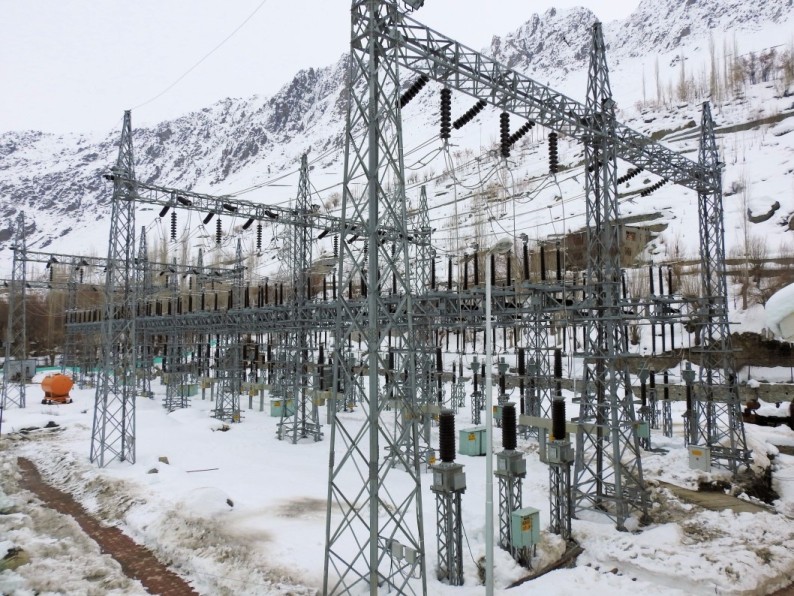On February 3, 2019, Prime Minister Narendra Modi dedicated the 220kV Srinagar-Alusteng-Drass-Kargil-Leh power transmission system to the nation. This was a defining moment in the history of India as the topographically challenged Ladakh region in Jammu & Kashmir, after over 70 years of Independence, got connected to the National Grid.
Project Contours
Type of transmission: Single circuit, 220kV
Length of transmission system: 335 ckm
Line components: Alusteng-Baltal (70 ckm), Baltal-Drass (44 ckm), Drass-Kargil (60 ckm), Kargil-Khalsti (96 ckm), Khalsti-Leh (61.5 ckm), LILO: Leh-Nimmo (66kV) and LILO: Leh-Kharu (66kV)
Substations: 50 MVA, 220/66kV GIS substations at Drass, Kargil, Khalsti and Leh
Project Altitude: 3,000m to 4,000m above mean sea level
Project Cost: Rs.2,266 crore (completion cost)
Foundation stone laid: August 12, 2014
Gestation period: Around four and a half years (since laying of foundation stone)
Project financing: Government of India (95 per cent), Government of J&K (5 per cent)
Implementation agency: Power Grid Corporation of India Ltd
Project owner: Jammu & Kashmir Power Development Department (J&K PDD)
Till November 2017, which was when the first component (Leh-Khalsti) of the Srinagar-Alusteng-Drass-Kargil-Leh power transmission system was commissioned, there was no electric connectivity to the Ladakh region. The Ladakh region got its electricity from local micro-hydropower projects aggregating some 14 mw, and diesel generators worth 12 mw. The energy shortage in the Ladakh region was as high as 95 per cent.
With the Srinagar-Leh power transmission line now commissioned, the Ladakh region can receive power from the National Grid. It may be mentioned that NHPC has commissioned two hydropower projects – Chutak (44 mw) and Nimmo Bazgo (45 mw) –in J&K. Located in Kargil district, the Chutak project is designed to supply its entire power generation to the Kargil district. The Nimmo Bazgo project, situated in Leh district and fully commissioned in June 2013, will be supplying its entire power generation to J&K, which means that not all electricity generated will be dedicated to the Leh and Kargil districts.
During the summer, the Ladakh region will receive electricity from the two hydropower projects and during winters, when hydropower generation is sub-optimal, the Srinagar-Leh line will enable import of electricity from the northern component of the National Grid.
The erstwhile Leh district was bifurcated into Leh and Kargil in 1979. Ladakh, covering around 60,000 sqkm, broadly refers to the region included by both Leh and Kargil districts. Ladakh covers around 70 per cent of the total geographical area of Jammu & Kashmir. The difficult terrain of Ladakh has left this region isolated, with very low density of population. According to the 2011 Census, the density of population of Leh district, which has an area of around 45,000 sqkm, is only 3 persons per sqkm. The comparable metric for Kargil is around 10 persons per sqkm.
Downstream connectivity: The 220/66kV Srinagar-Leh transmission line will be maintained by J&K PDD. The downstream sub-transmission and distribution network at 66kV level will be implemented under the Deen Dayal Upadhyaya Gram Jyoti Yojana (DDUGJY).
Government approval: In January 2014, the Cabinet Committee on Economic Affairs (CCEA) approved the Srinagar-Leh transmission line at an estimated cost of Rs.1,788.41 crore (at October 2012 price level). The commissioning schedule was planned as 42 months from the date of release of first installment of funds, which took place in March 2014. Accordingly, the approved commissioning schedule of the project worked out to September 2017. However, the project was not fully commissioned by then, though one segment (Leh-Khalsti line) was commissioned in early November 2017.
Socio-economic benefits: The main objective of the Srinagar-Leh transmission line is to provide round-the-year electricity, and that too at economical rates, to the largely disconnected Ladakh region. With reduced dependence on diesel generating sets, there will be positive implications on the pristine ecological conditions of the Ladakh region. The hospitality sector in Ladakh will also get a boost, thereby accelerating employment opportunities. For the local population, an electricity connection will never fail to usher in socio-economic development and an improvement in quality of life. Electrification in Ladakh will also help high-altitude military posts to become more functional and productive. Electricity supply to Ladakh also opens the possibility of putting up smaller substations to help electrify passes and military zones near the Line of Control.
Featured photograph gives a view of the switchyard associated with NHPC’s 44-mw Chutak hydropower project in Kargil district. This hydropower, along with NHPC’s 45-mw Nimmo Bazgo hydropower plant, will be feeding electricity to the Ladakh region through the newly-commissioned 220kV Srinagar-Leh transmission line. (Photo: NHPC)



